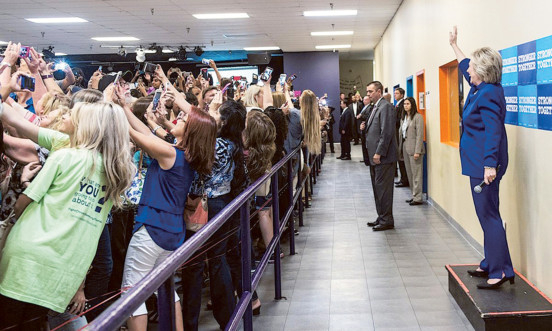
It is a curiously grotesque image. While a tightly packed crowd all took selfies with the Democratic party’s presidential candidate in the United States, a sly photographer slipped around the side. The resulting view is unflattering — not only to Hillary Clinton, but the crowd. They all have their backs turned to her while they hold up phones to take pictures of ... themselves, with the blue-suited Hillary in the background. No one seems to want a picture just of the candidate. It’s a selfie or nothing.
Meanwhile, waving and smiling, Hillary cuts an eerily isolated figure on her little stage, up against the wall, separated from the selfie-shooters by a railing, like a Francis Bacon Pope in his glass booth. Cue jeremiads on Twitter against our stupid, selfish, vacuous age. The dark side of digital democracy is so dark that we can’t even see ourselves. We rage against social media, on social media, lament the selfie ... on Twitter, a social media platform famous for restricting its profound essayists to 140 characters. Uh-huh.
Yet, there may be more to this picture than a grim revelation of the idiocy of our age. It may not quite be the hellish vision of democracy’s death in the echo chamber of digital self-regard that it superficially appears to be. At least I hope so, because Hillary is currently the last best hope for western civilisation, the final wall against the coming Age of Donald Trump, the Republican presidential nominee. If the image this picture seems to present is true, we’re all damned. Looking lost and ignored as people turn their backs on her to preserve their own faces for posterity — me with that politician! — the only sane choice in the 2016 US presidential election is visibly lost in trivial-mindedness. What hope of getting her arguments across if the crowd is too distracted by selfies to listen? And if the criterion of victory is going to be celebrity impact in a low-attention-span culture, the horrific truth shows its orange face: In a race to the bottom of modern culture, Trump cannot lose.
Yet, this picture may not be as bleak a comment on the modern world as all that. It takes a side-view that reveals the comedy of contemporary mores — but are these people really behaving so very badly? Imagine a photograph of the same scene taken from a different angle, facing the crowd of selfie-seekers full-on. It might be rather moving and impressive. It would show Hillary Clinton in the distance, with a mass of admirers who all face the camera as they take their pictures with her.
For who are we actually seeing here? A large group of mostly younger women all excited to be in the same frame as Hillary Clinton. They are not turning their backs on her in contempt. They are simply turning round so they can photograph themselves with her. Is that a narcissistic thing to do, or does it show exactly the sense of history that someone should have when they encounter the woman who may soon be president of the U? Is this a scene of shallow self-regard or sincere political enthusiasm?
2016 is clearly the year the selfie went political. At the Labour party conference in Britain, people were reportedly queueing up to have selfies with Labour leader Jeremy Corbyn and other heroes of the hour. I myself treasure my selfie with Len McCluskey. The same thing is going on here. Taking a selfie has now become the natural way for many people to mark important events, from dates to nights out to weddings — why not great political moments as well?
Democratic equivalent
Traditionally, portraits were painted of rulers and leaders at weighty historical moments. Velazquez’s masterpiece, The Surrender of Breda , and Titian’s portrait of Phillip II offering his son as a sacrifice for victory at the Battle of Lepanto use all the resources of oil painting to portray people in history. Perhaps what these women are doing is the democratic equivalent — they are expressing their sense of history with the resources they hold in their hands: Their phones.
The trouble with dismissing selfie takers as “narcissists” is that it assumes that every selfie means the same to everyone who has ever taken one. We all use our phones in this way now and when a gesture becomes conventional, its meanings can be almost infinitely varied. Every single photographer in that crowd may be a PhD in political theory, who is taking a selfie ironically to send to fellow faculty members at Princeton. In a culture that licenses and promotes stupid acts you can’t assume everyone who goes along with convention is stupid, let alone a cold-hearted narcissist
We won’t know the truth about this picture, and about our time, until the US election results are in. This American election may produce hell or hope. It may leave the entire world in the grip of a very dangerous man, or it may mean that the US gets its first female president to follow its first black president. Our digital age is also being tested. Has the escalation of social media, including the endless sharing of selfies, degraded and destroyed proper political debate? Is the echo-chamber of sharing similar views on Twitter and Facebook empowering monsters to destroy democracy? If that is the apocalyptic truth of our age, this picture is an allegory of it. As they concentrate on sharing their selfies with their friends, these people turn their backs on reality. But maybe it’s not that bad. Maybe they sincerely want to record a great historical moment. And maybe they will be part of Hillary’s majority and the democratic world’s recovery of reason.
— Guardian News & Media Ltd
Jonathan Jones writes on art for the Guardian and was on the jury for the 2009 Turner prize.








